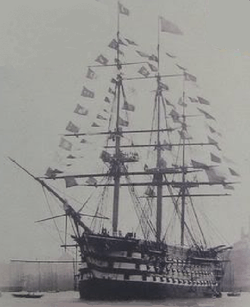Ottoman ship Mahmudiye
 Ottoman Navy ship-of-the-line Mahmudiye (1829) in Constantinople | |
| History | |
|---|---|
| Name: | Mahmudiye |
| Owner: | Ottoman Navy |
| Builder: | Imperial Arsenal, Constantinople |
| Launched: | 1829 |
| Decommissioned: | 1874 |
| Honours and awards: | Title of Gazi awarded to the ship for her role during the Siege of Sevastopol (1854–1855) |
| Fate: | Broken up |
| General characteristics | |
| Displacement: | unknown |
| Length: | 76.15 m (249.8 ft) |
| Beam: | 21.22 m (69.6 ft) |
| Armament: | 128 guns on three decks |
Mahmudiye was a ship of the line of the Ottoman Navy. She was a three-masted three-decked 128-gunned sailing ship, which could perhaps be considered to be one of the few completed heavy-first rate battleships. Mahmudiye, with a roaring lion as the ship's figurehead, was intended to serve to reconstitute the morale of the nation after the loss of the fleet at the Battle of Navarino in 1827. The flagship was for many years the largest warship in the world.
.jpg)
She was constructed by the naval architect Mehmet Kalfa and the naval engineer Mehmet Efendi on the order of Mahmud II (reigned between 1808–1839) at the Imperial Arsenal, on the Golden Horn in Constantinople.
The 201 × 56 kadem (1 kadem = 37.887 cm) or 76.15 m × 21.22 m (249.8 ft × 69.6 ft) ship of the line carried 1,280 sailors on board.[1]
With the introduction of steam power at the end of the 1840s, the conversion of the pure sail-driven ship into a steamer was considered. However, the lack of the necessary space for the steam engine on board meant the idea could not be realized.
Mahmudiye participated in the Siege of Sevastopol (1854–55) during the Crimean War (1854–56) under the command of Admiral of the Fleet Kayserili Ahmet Pasha. She was honored with the title Gazi following her successful mission in Sevastopol.
She was decommissioned in 1874 and broken up at the Imperial Shipyard.
Notes and references
Further reading
- Bulgurcuoğlu, Hacer. Efsane Gemi Mahmudiye Kalyonu. Deniz Kuvvetleri.
- Bulgurcuoğlu, Hacer (2007). "Türk Deniz Harp Tarihinde İz Bırakan Gemiler, Olaylar ve Şahıslar". Piri Reis Araştırma Merkezi Yayını. İstanbul: Deniz Basımevi (8). ISBN 975-409-452-7.
- İşcan, Nejat (2000). Fotoğraflarla Mahmudiye. İşcan Yayınları. p. 35. ISBN 978-975-96495-7-9.
External links
-
 Media related to Ottoman ship Mahmudiye at Wikimedia Commons
Media related to Ottoman ship Mahmudiye at Wikimedia Commons